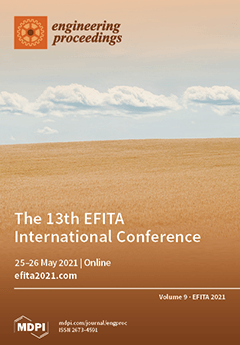Eng. Proc., 2021, EFITA 2021
The 13th EFITA International Conference
Online | 25–26 May 2021
Volume Editors:
Dionysis Bochtis, Institute for Bio-Economy and Agri-Technology (IBO), Greece
Maria Lampridi, Institute for Bio-Economy and Agri-Technology (IBO), Greece
Charisios Achillas, International Hellenic University, Greece
Dimitrios Aidonis, International Hellenic University, Greece
Dimitrios Kateris, Institute for Bio-Economy and Agri-Technology (IBO), Greece
Aristotelis Christos Tagarakis, Institute for Bio-Economy and Agri-Technology (IBO), Greece
Ilias Platis, University of Thessaly, Greece
Lefteris Benos, Institute for Bio-Economy and Agri-Technology (IBO), Greece
Printed Edition Available!
- Issues are regarded as officially published after their release is announced to the table of contents alert mailing list.
- You may sign up for e-mail alerts to receive table of contents of newly released issues.
- PDF is the official format for papers published in both, html and pdf forms. To view the papers in pdf format, click on the "PDF Full-text" link, and use the free Adobe Reader to open them.




